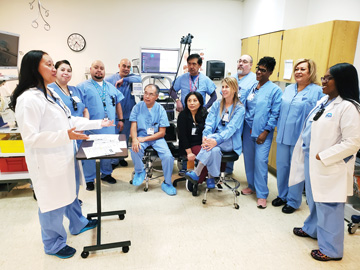Six Surface Disinfection Concepts
The puzzle of superior surface disinfection is never solved....
This website uses cookies. to enhance your browsing experience, serve personalized ads or content, and analyze our traffic. By clicking “Accept & Close”, you consent to our use of cookies. Read our Privacy Policy to learn more.
By: Muriel Moyo, MS, BSN, RN, CCRN-K, NE-BC
Published: 11/18/2021
At its core, shared governance is nothing more than giving the people who do the actual work a voice in how that work is done. While that sounds like common sense, surgical leaders everywhere know this isn’t often the case in health care.
All too often, instead of a shared-governance model where frontline nurses feel empowered to create ideas that will affect day-to-day operations, many facilities adhere to a strict top-down hierarchy where staff are simply given marching orders and expected to follow them. Sometimes this is due to a toxic culture, but in many cases a lack of shared governance simply comes down to a frontline team not having the proper framework in place to make change happen.
At our facility, we saw a surge in staff ideas when we rolled out a formal process they could use to suggest changes they felt would improve patient care. The process is structured around the acronym CONNECT (Communicate, Own, Navigate, Negotiate, Engage, Collaborate and Teach) and was based on a concept I’d read about in a book titled, “Manager 3.0: A Millennial’s Guide to Rewriting the Rules of Management”. Here’s how you can take this framework and apply it to your own staff.
• Communicate. Shared governance always starts and ends with communication. Your staff must feel empowered to speak up when they have a solution to a problem or a better way to do something. For instance, one of our charge nurses came up to me and said, “Hey, we should have transport monitors, so we can track our patients between their levels of care.” We had been using a bulky device prior to switching over to the portable transport monitors we currently use. Rather, than saying “OK, we’ll look into that for you,” we turned around and asked her to lead the effort in researching the options and developing a proposal to add the monitors.
• Own. When an idea or solution with some merit is brought forward, make sure the nurse or tech takes full ownership of what comes next. In the case of the transport monitors, that charge nurse spearheaded and was involved in everything from the vendor selection process to training staff on the new equipment. This is easier said than done, as it’s natural for staff to worry about repercussions for something not panning out. Surgical leaders play a pivotal role here. You must create a safe environment where staff can be innovative and take certain risks, even if the idea ultimately fails.

• Navigate. The third step of the CONNECT is essentially your road map. Where do you go for answers? In revisiting our monitor example, the charge nurse had to navigate our equipment purchasing protocols, the vendor-quoting process and all that’s needed to effectively make the case for implementing the idea brought up in the communication stage. This is where your staff is gathering evidence, pulling together resources and collecting the information they need to show there’s a ROI to making their suggested change.
• Negotiate and Engage. These two steps are combined because they generally go hand in hand; you can’t negotiate with someone who isn’t engaged. Once you have everything you need to support an idea, you must get buy-in from the top decision-makers. When it comes to equipment purchasing, for instance, you must justify why you need what you’re asking for.
• Collaborate. While you want your staff to be the driving force behind any idea they suggest, at some point the process becomes collaborative. Our charge nurse had to work with the monitor vendor, our supply managers (because they’re ultimately the ones who will send in the purchase order) and the rest of the clinical team. As a surgical leader, you need to be there to facilitate smooth interactions between the various groups to ensure collaboration occurs.
• Teach. The final step in our shared governance model is arguably the most important. No matter how much effort you put into an idea, it won’t come to fruition if your staff isn’t properly trained or doesn’t buy into the process. That’s the beauty of shared governance. Who better to train your staff on the intricacies of a new process or piece of equipment than one of their peers?
Whenever you can get one of your frontline nurses or techs to take an idea and run with it, the effect is contagious. There’s a lot of research showing that when staff are allowed to come up with their own solutions, they will own the results and become an outspoken cheerleader in the department for that change. Once other staff see this, they will bring their own ideas to the table. This is ideally how you want your facility to run. In surgery, leaders are often more like spectators than players. Your staff has the best ideas, they know what’s worked, what hasn’t and all the key details. It’s up to you to provide the support they need to bring those ideas forward — and a well-defined shared-governance process is a proven way to make it happen. OSM
The puzzle of superior surface disinfection is never solved....
Boston Children’s Hospital is renowned for its exemplary care on many fronts, including surgery....
Manual cleaning done properly is effective for eradicating microorganisms....